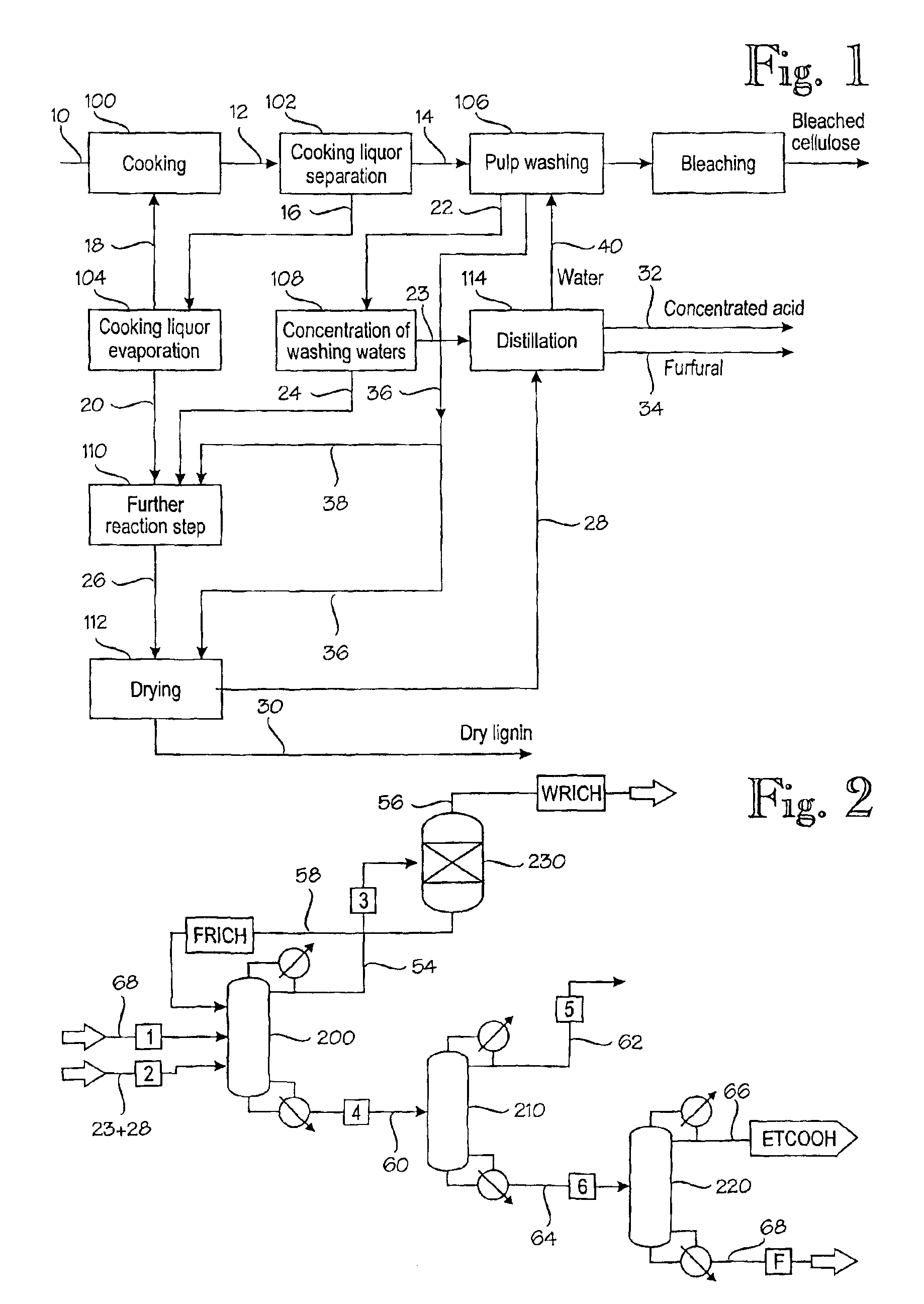Method for producing furfural, acetic acid and formic acid from spent pulp-cooking liquor
- Summary
- Abstract
- Description
- Claims
- Application Information
AI Technical Summary
Benefits of technology
Problems solved by technology
Method used
Image
Examples
example 1
[0082]Bagasse was cooked using a cooking acid mixture containing 42% of formic acid and 40% of acetic acid. The cooking liquor (initial dry solids content approx. 5%) was separated from delignified bagasse pulp and concentrated by evaporation at a temperature of 62 to 70° C. to a dry solids content of 24.2%, the furfural content of the cooking liquor being 0.3% and the amount of xylose in the dry solids 37.3%. The concentrated cooking liquor was evaporated on pilot scale using a single-phase thin film evaporator at a pressure of 0.2 bar at different temperatures. The contents of dry solids, xylose and furfural were measured from the evaporation concentrate. The results are shown in Table 1 (the xylose contents have been calculated from the dry solids).
[0083]
TABLE 1JacketConcentrateConcentratetemperature (° C.)Xylose (% by wt.)Furfural (% by wt.)13021.40.615019.30.616016.90.717010.51.1
[0084]It appears from the results that xylose is decomposed and furfural formed. The results also sh...
example 2
[0086]Bagasse-containing cooking liquor (initial dry solids content approx. 5%) was concentrated as described in Example 1 and evaporated in a pilot evaporator at a pressure of 0.2 bar. The dry solids content of liquor was 35.7%. The evaporator was heated by a rotating steam coil. The contents (% by weight of the dry solids) of bound acids, i.e. formic acid (HCOOH) and acetic acid (AcOH), and xylose were measured from the feed and product concentrates. The results are shown in Table 2.
[0087]
TABLE 2Bound HCOOHBound AcOHFree xylose(% by w.)(% by w.)(% by w.)Feed2.39.125.3Product1.03.1 1.4
[0088]The results show that xylose included in the concentrate decomposes as in Example 1. This can be seen as formation of furfural. It was also noticed that de-esterification occurs.
example 3
[0089]Bagasse-containing cooking liquor (initial dry solids content approx. 5%), which had been concentrated by evaporation to a dry solids content of 28%, was reacted at a temperature of 130° C. in laboratory reactors. Samples were taken from the reactor contents, from which the contents of furfural, xylose, formic acid, acetic acid and solids and the amount of bound acids were analysed at the beginning and at the end of the reaction. The measurement results are shown in Tables 3a and 3b. Table 3a illustrates how the xylose, furfural and dry solids contents changed in the reactor tests and Table 3b illustrates acid formation in the reactor tests (xylose contents were calculated from the dry solids). In Table 3b the expression “acids formed” refers to the acids that were formed as a result of the decomposition.
[0090]
TABLE 3aSolidsXyloseFurfural(% by wt.)(% by wt.)(% by wt.)At the beginning27.720.01.2At the end21.0 5.75.4
[0091]
TABLE 3bFree AcidsBound Acidsc(acid)c(acid)At theAt theAc...
PUM
| Property | Measurement | Unit |
|---|---|---|
| Temperature | aaaaa | aaaaa |
| Temperature | aaaaa | aaaaa |
| Temperature | aaaaa | aaaaa |
Abstract
Description
Claims
Application Information
 Login to View More
Login to View More - R&D
- Intellectual Property
- Life Sciences
- Materials
- Tech Scout
- Unparalleled Data Quality
- Higher Quality Content
- 60% Fewer Hallucinations
Browse by: Latest US Patents, China's latest patents, Technical Efficacy Thesaurus, Application Domain, Technology Topic, Popular Technical Reports.
© 2025 PatSnap. All rights reserved.Legal|Privacy policy|Modern Slavery Act Transparency Statement|Sitemap|About US| Contact US: help@patsnap.com

